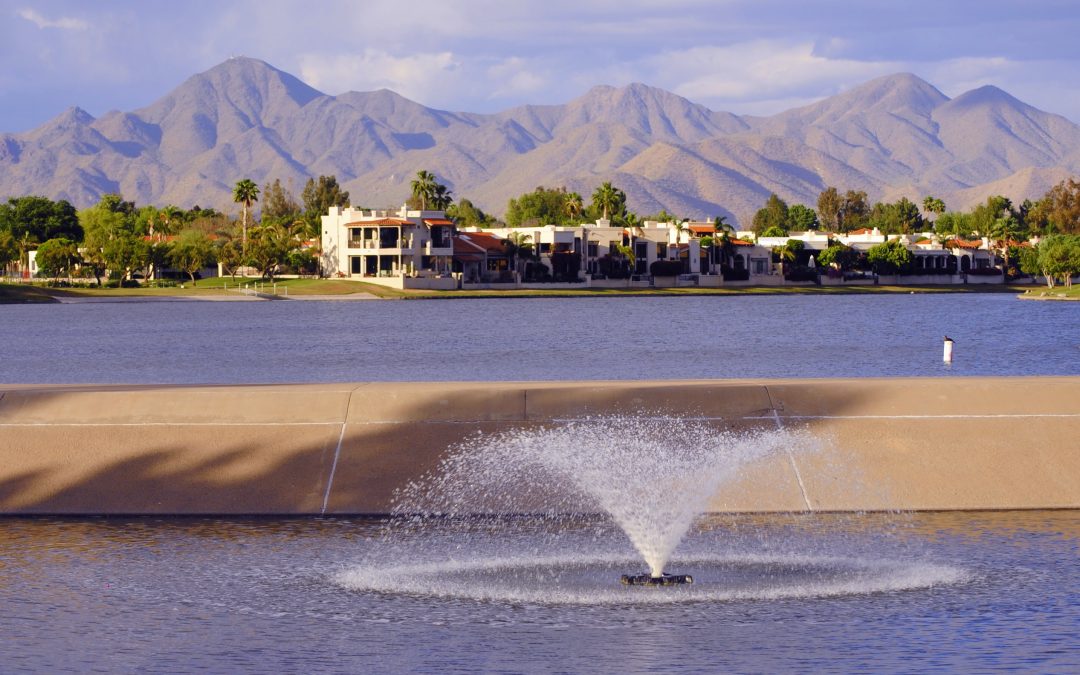
by Paul Slaybaugh | Apr 30, 2009 | Home Buying, Scottsdale, Scottsdale Neighborhoods

Lake Margherite in McCormick Ranch
Water is a precious commodity in the desert. Dependent upon the CAP (Central Arizona Project) and SRP canal systems to fill our taps and water our lawns with the liquid gold of the Colorado and Salt Rivers, we do not squander our lifeblood frivolously … with the notable exception of Slip-N-Slide Saturdays, of course. Given the grand total of naturally occurring lakes in the Valley of the Sun stands at exactly zero, we denizens of the creosote jungle are drawn to a droplet of water like mercury to the top of a Sonoran thermometer. We weekend at Saguaro Lake or Lake Pleasant. We make semi-annual pilgrimages to the sandy beaches of southern California. We float the Salt River amongst a throng of Memorial Day humanity that is equal parts Coppertone and the AC/DC Back in Black album. We secretly adore the rains that the summer monsoons bring.
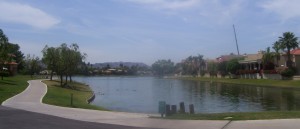
Given our propensity to flock to that which is scarce, waterfront communities are highly desirable locales in the greater Scottsdale area. There are few communities within the boundaries of the West’s purportedly Most Western Town that boast lakes on the list of amenities, and there is a reason for that.
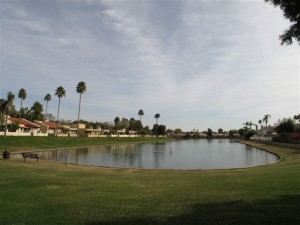
When McCormick Ranch was originally developed in the 1970s, it was to be the first master planned community in Scottsdale. Believe it or not, the Hayden and Indian Bend Rd intersection (where initial development of McCormick Ranch began) was considered North Scottsdale at the time. There was really nothing else around. To lure skeptical home buyers away from the downtown Scottsdale area (what we now refer to as “Old Town”), developers threw the entire kitchen sink at them: parks, greenbelts, walking paths, golf course and lakes. Including Lake Angela, Lake Nino and the crown jewel, Lake Margherite, the community is a veritable desert oasis.
When Scottsdale Ranch was developed a decade later, planners adhered to many of the same guiding principles. East of McCormick Ranch, it was built around a lake system, walking paths and parks in much the same fashion. Once again, developers knew they needed to give people a reason to venture a little off the beaten path to buy their product. They were selling a lifestyle as much as housing. That lifestyle revolved around a meandering 42 acre waterway by the name of Lake Serena.
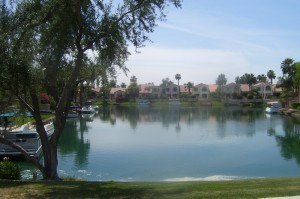
Flash forward a couple of decades and developers, by and large, stopped providing such extravagant amenities. The area had become well established and new residents came in droves. Land values shot through the figurative roof and builders saw no literal need to plop a man-made lake down on a parcel of land that could instead be used to build and sell another 100 or so more houses.
As such, there are relatively few waterfront options in Scottsdale outside of these two master planned communities. They just don’t build’em like they used to. While properties along the water in both developments are typically quite expensive, there are patio home and condo options that fit less extravagant budgets. To help you get started with your waterfront search, following is a compilation of lake subdivisions located within McCormick Ranch and Scottsdale Ranch.
*You may wish to bookmark this page as each subdivision name will eventually include a link to detailed descriptions and current active listings. It’s a work in progress.
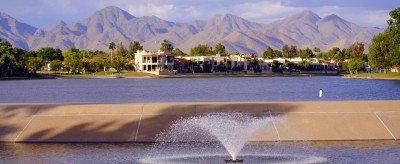
McCormick Ranch
Vista Del Lago
Island At McCormick Ranch
Palo Viento 1
Heritage Village
Las Palomas
Scottsdale Ranch
Landings at Scottsdale Ranch
Las Brisas
Lake Serena Estates
The Bay Club
Lakeview Estates
Bayview Estates
Waterfront
Monterey Point
Charter Front
For less costly options that are near the water, but not necessarily located right on it, there are a few older neighborhoods further South (closer to Old Town) that abut Chaparral Park. While the homes (and townhomes) in the area are far removed from the luxury market, it is a great option for those more concerned with location and amenities on a shoestring budget. For high end townhomes, there is the Scottsdale Waterfront option along the canal banks in downtown Scottsdale (Old Town). Pages dedicated to these neighborhoods will be added to the site over the coming weeks as well.
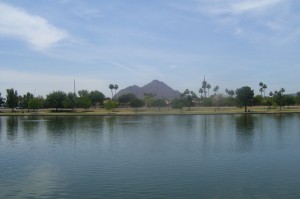
The right Scottsdale waterfront property is out there. We’ll help you find it.
Contact Ray & Paul Slaybaugh today to start the search for your Scottsdale AZ waterfront home!
(480) 220-2337 | paul@scottsdalepropertyshop.com
by Paul Slaybaugh | Apr 17, 2009 | Home Buying, Scottsdale Real Estate
Times were you looked at a few houses, found one you liked and made an offer to the current owner. After a bit of haggling, you settled on a price that both parties could live with and away you went. Easy as pie.
In the current landscape, however, buying a home is not always that simple. Due to the prevalence of foreclosure properties and upside down sellers in today’s market, a buyer is often in the dark as to the nuances that may vary from one property to the next. To that end, there are certain rules of thumb that a buyer should keep in mind as he or she navigates the 2009 Scottsdale Real Estate market.
1. The Short Sale Property

"Upside down, boy you turn me, inside out ..."
You’ve read about them in the paper, heard about them on the news and know somebody who attempted one, but still may not know exactly what a short sale is. First off, I would be remiss if I didn’t make the requisite quip that short sales are anything but short. By and large, they are loooooooooooooooooooooong.
The term “short sale” is derived from the seller’s lack of equity in the property. In fact, the seller is upside down to the point that the market value of the home is less than what is owed on the mortgage(s). With a short sale, the seller must convince the bank to take a loss by agreeing to the sale. There are numerous pitfalls, including waiting for weeks or months for the lienholder’s response and low success rates (less than 10% of short sales are successful). One particular difficulty lies in ascertaining whether a seller even qualifies for a short sale at any price. Each institution has its own unique standards, but sellers must adequately demonstrate hardship (job loss, etc), provide up to date financial statements and pay stubs, document where all funds for a line of credit have gone (the lender in 2nd position will disallow a short sale if the funds went anywhere except back into the house (kitchen remodel, pool, etc). The biggest saboteur of a short sale, other than an incompetent listing agent, is the presence of a second loan. Multiply the difficulty exponentially if the loans are held by different institutions.
If it sounds like a lengthy, treacherous process, that is because it often is. Short sales, in this agent’s humble opinion, only make sense for the buyer with no real time table. Investors, specifically, are primed to take a stab at one if the purported price (the price listed in the MLS is really just a moving target when you don’t know what the bank will ultimately deem acceptable) is attractive enough. If you don’t plan to live in it, and won’t be devastated if it doesn’t pan out, have at it.
2. The Foreclosure Property

I'll take a single-family home and $20 cash back, please
If 2009 could be summed up by initials, they would be “REO.” Real Estate Owned properties, or foreclosures, are all the rage this season, and for good reason. Banks are awash in foreclosed homes at present and have effectively set the market. Eager to rid themselves of bloated inventories, the various institutions have well-earned reputations for bargain basement pricing. By the time a bank takes a property back from an owner in default via a Trustee’s Sale, I find they are often ready to deal. If the short sale process can feel like a rudderless vessel as your offer drifts from file to file in the bank’s loss mitigation department, there is actually a captain at the helm by the time the bank ultimately rejects the offer(s) and opts to foreclose instead. Now an asset manager is responsible for offloading the acquired property. Just the titles alone speak volumes as to the motivational forces at play:
loss mitigation VS asset management
More often than not, a property that is taken back by the bank will reemerge as an REO property at an even lower price than the listed price of the failed short sale attempt. Does it make sense? Not really, but that’s what often happens. And the price is no longer a moving target. With the bank now the principal, they set the list price and will negotiate more like a typical seller (albeit at a slightly slower and more aloof pace). Expect to wait up to a week for a response and the possibility of fighting off multiple offers due to the low pricing, but it sure beats waiting months for an all too often unreasonable response.
The negatives of dealing in bank-owned property are primarily rooted in lack of disclosure about the home and the penchant for selling property “as is.” You can be sure that something will be missing from the home. Either vandals have cannibalized the A/C for copper or the former owner yanked all of the appliances and the hall bath towel rack out of the home on the way out, but rest assured, some component of the house is FUBAR. Complete with heavy handed addenda that favors the seller, the trade off for the great price on a bank property is an often uncared for home with no disclosed history of damage/repair and no one to repair the defects you find during the course of your due diligence period.
Yes, you do get the opportunity to inspect even though the bank will require an “as is” addendum. If you ever see language in a contract or addendum disallowing your right to inspect the property … run!
3. The Resale Home

Quick, Marge, get the camera ... real people!
Ah, a home actually owned and sold by a real, unencumbered person. I must confess, finding such a specimen in the modern Real Estate jungle has been a rarity. At least finding one that can compete with the pricing of bank-owned homes, that is. As more and more sellers become realistic about the erosion that has taken place in Valley home values, though, I am starting to see the gap close ever so slightly. Obviously, anyone who bought a home in 2005 or later is not in a position to competitively price it for today’s market without attempting a short sale due to the subsequent swan dive in prices, but those who have been in their homes for a decade or longer are finally getting the memo and positioning themselves to compete with the banks. With prices still trending downwards, the smart seller is getting out in front of the curve and pricing his/her home to sell before any further price degradation can occur. When you find such a home with a seller still capable of maintaining, disclosing and repairing the property’s condition, and priced in line with the foreclosure market … buy it!
So there is a (not so) brief synopsis. Don’t limit yourselves unnecessarily when shopping for a home. Allow your agent to explore all available avenues, just be aware of what you might be signing up for with the entanglements that come with each option.
Most importantly, remember this: A low price in the absence of value is meaningless.











